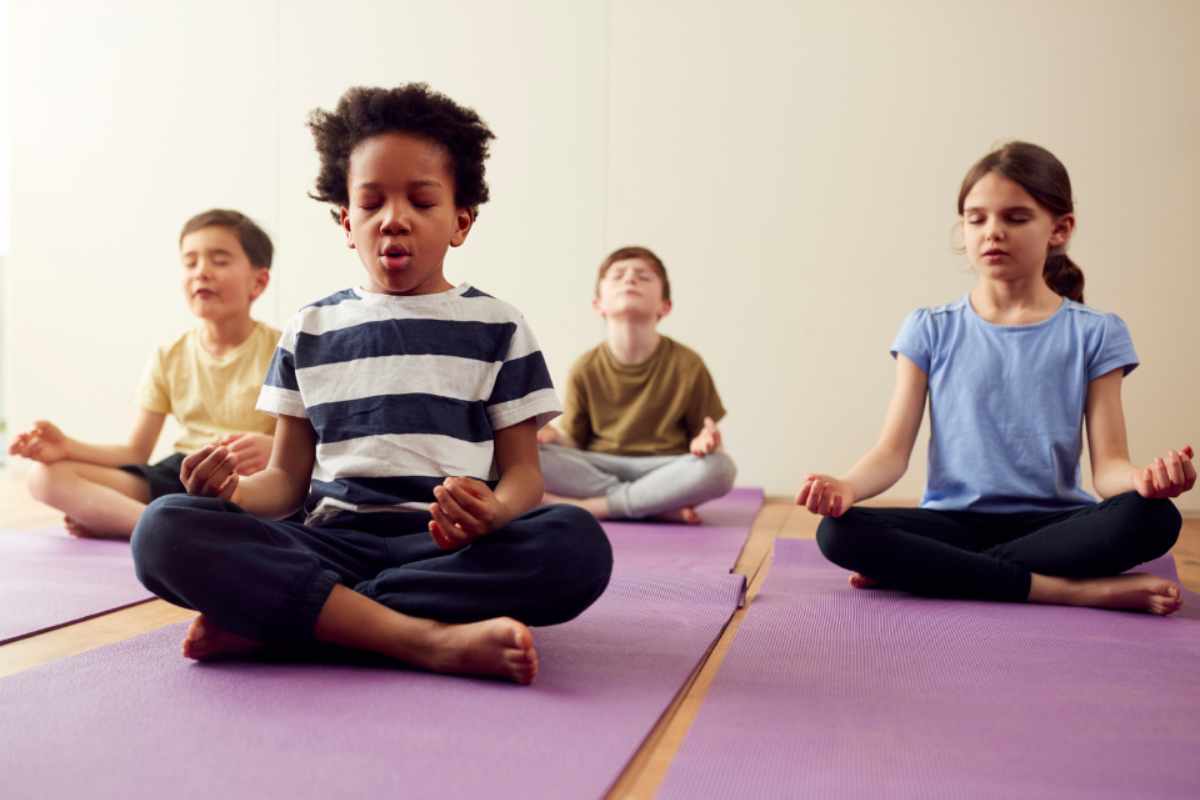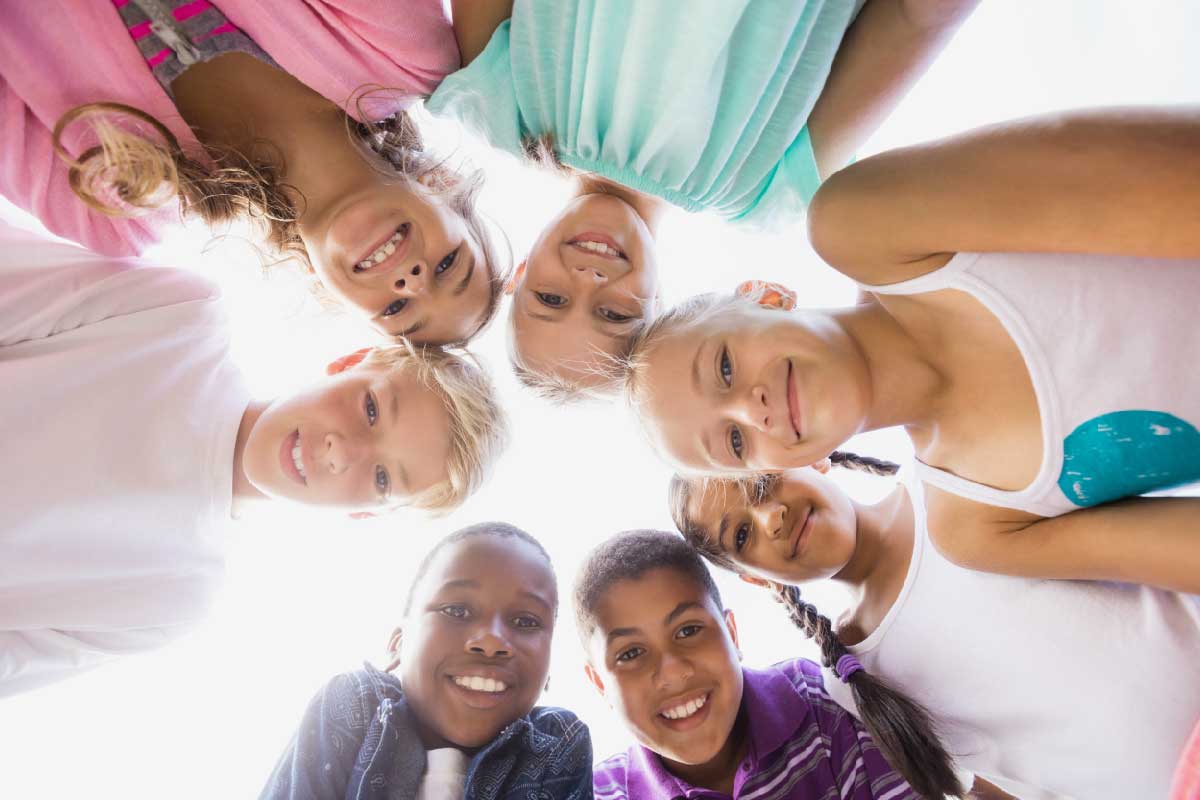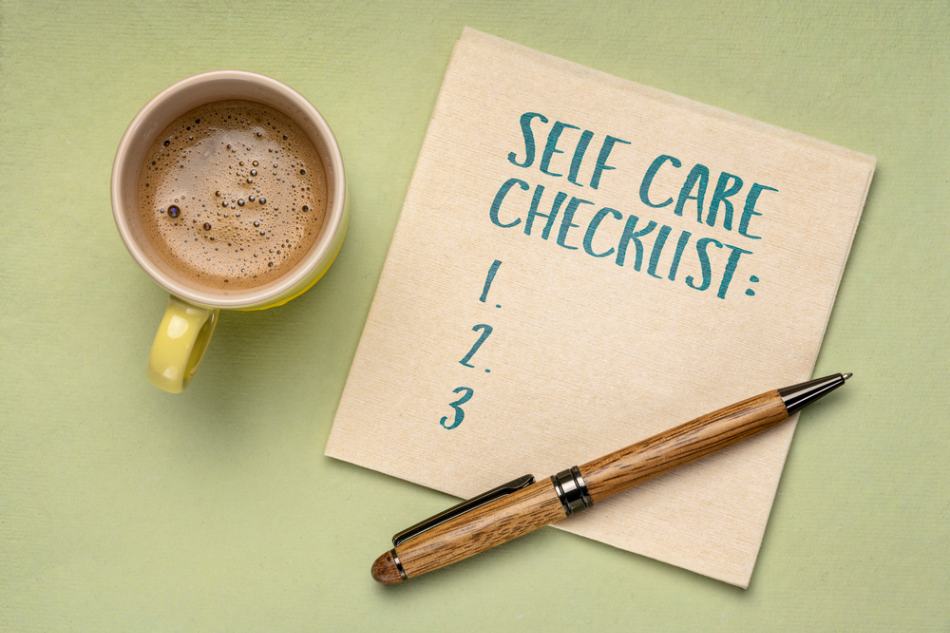December 9, 2021
Webinar: Introduction to Child-Centered Play Therapy
Written by Rachel Eddins
Posted in Child Counseling, Webinars and with tags: child counseling, play therapy

In this webinar, play therapist, Joey Harmon, LPC- Associate, gives an overview of child-centered play therapy.
Learn who can benefit from play therapy, how it works, and what to expect from a play therapy session.
Watch a replay of the presentation here.
Learn more about our child counseling services.
Here is a transcription of the webinar:
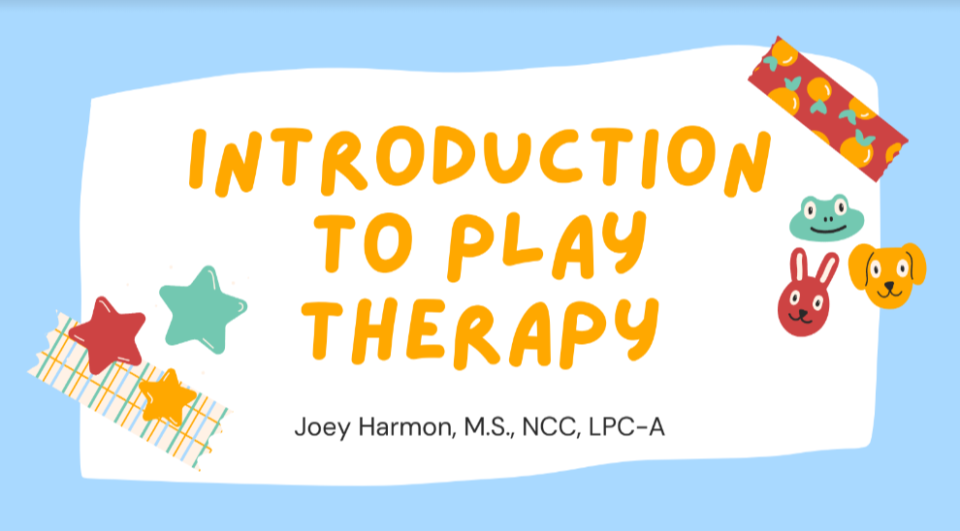
Hello, everyone! My name is Joey Harmon and I am a counselor and play therapist at Eddins Counseling Group in Houston. I earned my Bachelor of Arts in Psychology at nearby Houston Baptist University. Afterward, I went on to earn my Master of Science in Clinical Mental Health Counseling with a focus on In Play Therapy at the University of North Texas.
In addition, I’m a National Certified Counselor with the National Board of Certified Counselors, and I’m a licensed Professional Counselor Associate in the great state of Texas under the supervision of Diana Cabrera Stewart.
My experiences with children include working in summer camp settings, working at an ABA clinic for children on the autism spectrum, and currently as a play therapist. Today, I’m here to talk a bit about both play therapy and filial therapy as therapeutic interventions for children, as well as the specific type of play and filial therapies that I practice.
Agenda
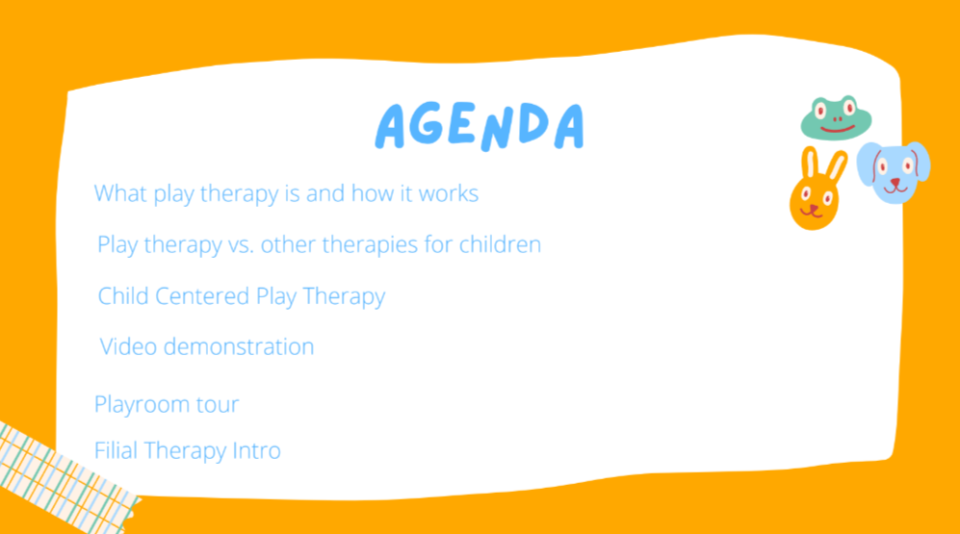
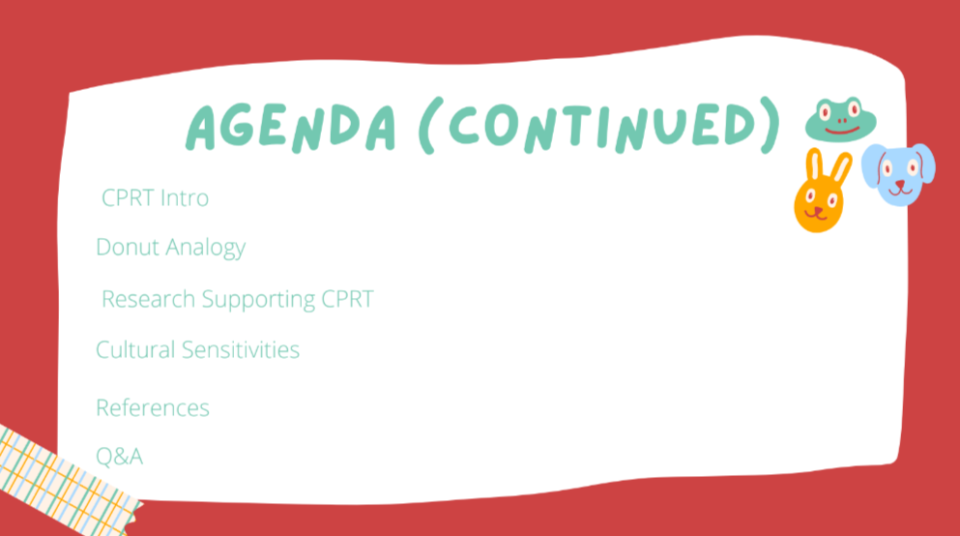
Here is our agenda for today. I hope to keep this presentation within roughly 45 minutes, with about 15 minutes in the end for Q and A section. So when we get to that point, please just make sure to keep your mics muted and post in the chat whatever questions you have. And we are also going to have various discussion points throughout this presentation tonight, so feel free to use the chat feature for that as well.
What is Play Therapy?

We’re going to get open with a very important question for tonight. What is play therapy? Well, play therapy is essentially how you do counseling with children. Instead of a typical therapy room, there’s a playroom. And instead of expecting the child to sit on a chair or sofa, they can roam around on the floor playing with the toys in a lot of the ways they’d like to.
Play therapy is reliant on the notion that children utilize toys and play in order to express themselves. As you can see in the quote here. Through play, children express what their lives are like now, what their needs are, events of the past, and or how they wish things could be.
Development
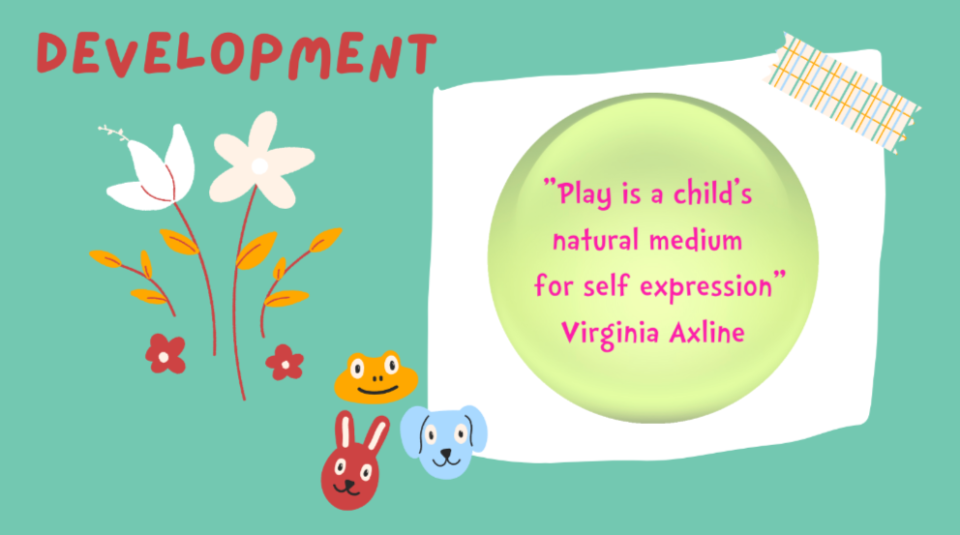
As you can imagine, it’s highly unlikely for a little five-year-old to come into a normal counseling room, plop down on the chair or sofa, and start rattling off about, in detail, how hard life is whatnot. So, little Susie isn’t going to come into my normal therapy room to sit on my couch and say: “Mr. Joey, I just had the worst day at school. I didn’t get a lollipop from the doctors today, and Mommy’s doing blah, blah, blah, blah, blah”. That’s just not appropriate.
Research has verified the quote to the right time and time again. Virginia Axline is the founder of child-centered play therapy, which I’ll get to in a little bit.
Most forms of play therapy are best for kids ages three to eight, although of course there can be exceptions. Even as kids enter pre-adolescents, aspects of play therapy, like the inclusion of certain toys and the use of certain phrases can be common.
But generally speaking, play therapy is meant for that three to eight age range.
Ultimately, a child’s brain is just not yet developed enough to express themselves verbally as adults and teenagers are able to do. In order to articulate the way they are feeling, children will naturally rely on play to communicate.
Eriksonian Stages

Those of you who are familiar with human growth and development or maybe took an intro to Psychology course at some point may recognize the Eriksonian theory of human development, created by the power couple you see to the right, Eric and Joan Erickson.
The Eriksons believe that life is a series of crises and that as we age, we move from one crisis to another. Each crisis is characterized by the individual feeling pulled between one of two sides. In order to successfully move on from one stage or crisis to the other, one must reconcile the challenges that come with these internal and external conflicts.
On the screen, you’ll notice three different stages. These are the Eriksonian stages that are related specifically to the ages of play therapy clients.
Autonomy vs. Shame and Doubt
The first is autonomy versus shame and doubt, and it lasts from roughly 18 months to three years of age. This stage is characterized by children learning how to do things independently of their parents for the first time. If they’re successful, they’ll develop a firmer sense of autonomy and independence. If they aren’t, they may develop low self-esteem and might either be very clingy to their parents or desperately try to prove themselves.
Now, you’ll recall from the previous slide that even the youngest play clients are only three years old, which is the upper end of the stage. But I included it here because there is the possibility of unresolved issues from this stage continuing to plague the child as they grow older.
The Eriksons believed that the way in which you handle a crisis influences the way you handle other crises, creating a foundation upon which you build the rest of your life.
Initiative vs. Guilt
Next, we have initiative versus guilt, which lasts from three to five years of age. During this time, children further develop their self-concept by figuring out what kind of person they are.
Am I a good kid or am I a bad kid?
Children who succeed in navigating the stage develop a sense of purpose in their actions and walk away with a better sense of who they ultimately are. However, there is the possibility for children to not develop this sense of initiative and instead feel guilty whenever they attempt something that doesn’t work out.
Industry vs. Inferiority
Finally, we have industry versus inferiority. This stage lasts from roughly five to 13 years old and is hallmarked by children figuring out what they’re capable of through social interactions and challenges.
As you can imagine, school life and friendships play a large role in this stage. Children emerge with a confident sense of industry if they generally see themselves as being competent at what they do, but may feel inferior if they don’t believe they are as capable as other kids.
So why am I telling you all this? Why am I spending so much time on this slide?
Play therapy helps to develop a child’s sense of independence, self-esteem, and sense of mastery, amongst other things.
No matter which of these stages a child may be struggling with in their development, play therapy can address these matters.
What Play Therapy Is and Isn’t
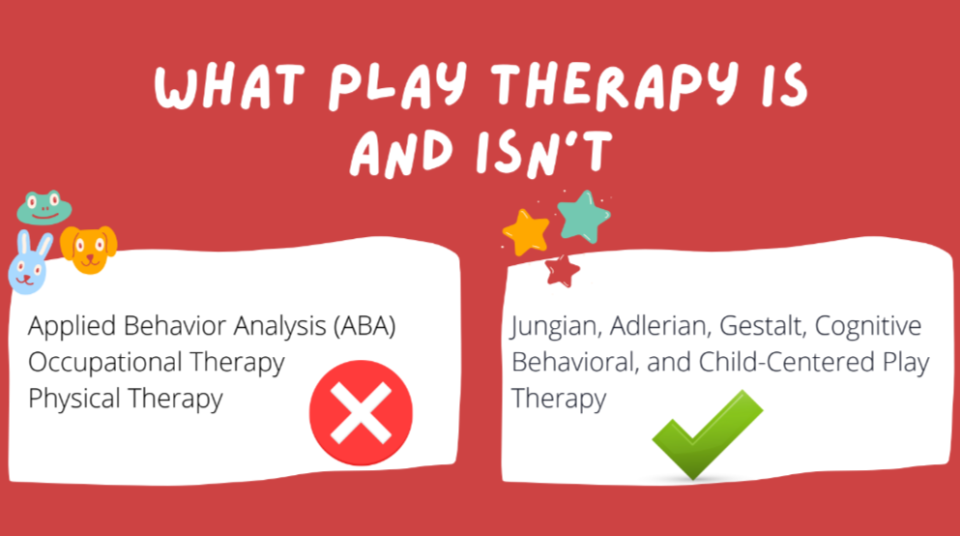
There are, of course, plenty of therapies that are geared toward children, and it’s common for them to incorporate play in some way, somehow. However, it’s important to keep in mind that these are not play therapy.
Play therapy is expressly for the purpose of psychotherapy or counseling. Modalities such as the ones on the left may very well utilize play, but it’s not done in the same way for the same reasons. Again, think of play therapy as counseling for kids.
Clients are referred to play therapy when they’re dealing with issues like anxiety, depression, low self-esteem, trauma, bullying, etc.
And yes, folks, children can significantly struggle with things like anxiety, depression, and trauma.
So these other three things here on the left are wonderful and they are great and they are absolutely needed and they just don’t do what we do. They’re all valid. They just by definition, are not play therapy.
The types you see on the right are examples of different kinds of play therapy. If you’re familiar with the world of counseling, you may recognize some of these as being from different types of counseling. Just like how there are different versions or theories of counseling, there are different versions and theories of play therapy.
Each one of these branch off from a well-established school of thought within psychotherapy. They are all great in their own way, but the type that I personally use and we’ll be going into greater detail is Child-Centered Play Therapy.
Child-Centered Play Therapy (CCPT)
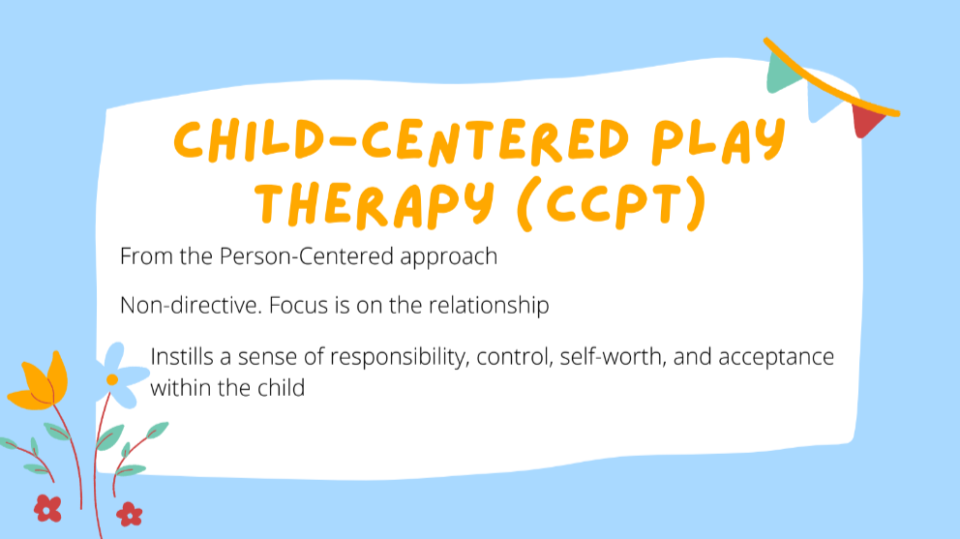
For those of you who are familiar with humanistic or person-centered counseling, Child-Centered Play Therapy stems from that tradition.
CCPT offers a completely nonjudgmental environment in which the child is free to use the toys and their time in a lot of the ways they want to.
When you see nondirective on here, that means the therapist does not come in with any sort of agenda. The therapist does not see the child as a problem to be fixed as if they were just some car brought into the shop for a tune-up. They see the child as a unique, holistic human being who just wants to be understood. As adults a lot of the time we just want to be understood, and therefore we should be extending that same grace to children.
And the therapist may end up being the very first person in the child’s life to provide such an understanding. The focus in child-centered play therapy is exclusively on the relationship. In doing so, the child must now be the ones who take ownership of their actions, bring themselves under control, realize they are capable of great things and accept themselves for who they are in the moment.
What Sets It Apart?
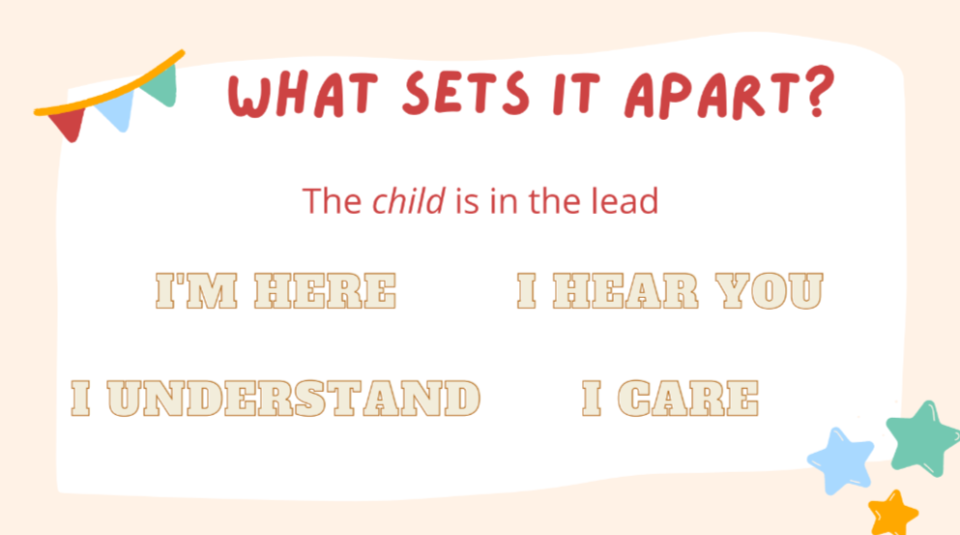
In the next slide, we’re going to go over the only things that ought to be going through the play therapist’s head as they interact with the child. As mentioned before, it is the child that takes ownership of their time in the playroom.
The CCPT playroom offers many children the very first sense of real control, responsibility, and liberty. On the screen, you can see the four core tenets of child-centered play therapy called the Be With Attitudes.
I’m here
The first one I’m here, I am physically present: now that one might seem like an obvious one to you all, but what that means is I’m not going to be lounging on the couch, I’m not going to just kind of halfheartedly slump in my chair while I glance over at the kid every once in a while.
I am sitting up, leaning in, and being physically in tune with what the child is doing. My nose and my toes are always oriented in the direction of the child because in doing so, I’m subconsciously conveying to the child that I’m giving them my undivided attention. So I’m here.
I hear you
I hear you: not only am I physically present, but I’m also mentally present. I’m not thinking about other clients, I’m not thinking about the notes that I have to do. I’m not thinking about my social life, and I’m not thinking about the mess that I’m going to have to clean up after the session is over.
Now, that’s not to say that my mind won’t wander every once in a while. Play therapist circumstance, believe it or not. But when my mind wanders, I make a concerted effort to bring my attention back to the child so that I am not only physically, but also mentally available.
I understand.
I understand. Or at least I want to understand. I’m doing my best to understand. Play therapists do what they can to put themselves in the shoes of the clients, doing whatever they can to try to see the world from the client’s point of view as much as possible.
So I’m here, I hear you, I understand and I care.
I care.
We do all of these things because we care about the child. This last one is essentially a call to action. It’s why we go into this field in the first place. It’s why we want to help children. I care.
I delight in you.
And there’s also a fifth attitude that’s being thrown around in plenty of play therapy circles called I delight in you. So that goes beyond just caring about the kid and genuinely taking joy and pleasure from living life with the child at the moment for those 45 minutes.
Efficacy of CCPT
This new way of working with children might seem strange to some of you all, and admittedly, it’s me at first as well. But the research doesn’t lie. Child Censored Play therapy has the most amount of research supporting its efficacy than any other form of play therapy, which is one of the reasons why I like it so much.

The ways in which child-centered play therapy helps kids are quite expensive, and the things listed on the screen are just some of the major highlights. If you are aware of children that might need help in any of these areas, it could be worthwhile to recommend play therapy to the parents.
Other notable ways in which play therapy has been shown to be helpful is allowing children the ability to develop self-regulation of emotions, instilling a sense of responsibility and independence, and/or if a child has issues with boundaries. Such services could be instrumental for parents that routinely bring up concerns that they’ve noticed in their children.
Dr. Gary Landreth
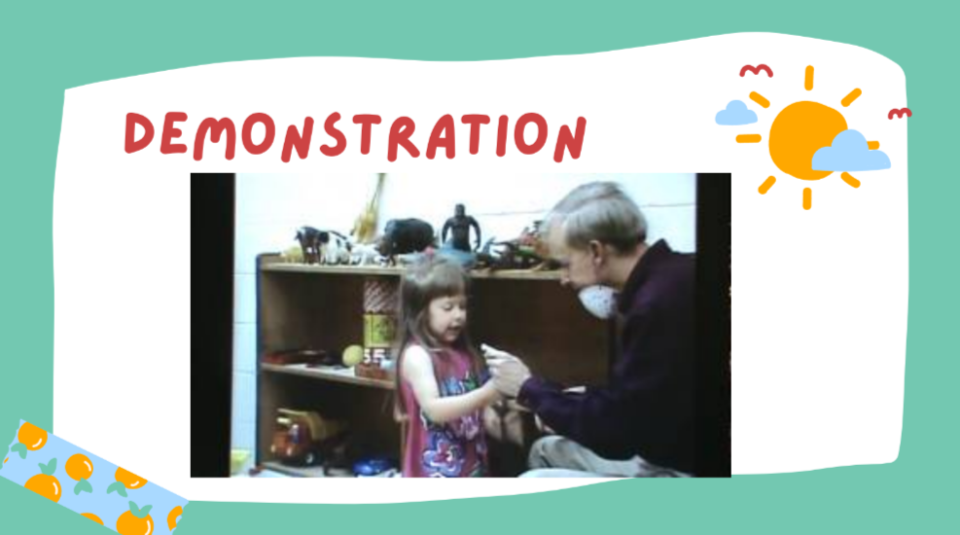
Now we’re going to be watching an eleven-minute clip roughly of a child-centered play therapy session. The therapist that you see on the right hand of the screen is Dr. Gary Landreth from the University of North Texas. And quite frankly, he’s great. He quite literally brought play therapy to Texas back in the 60s and founded the Center for Play Therapy.
If there was Mount Rushmore or child counselors, he would be on it. Just so you all know, Gary will pause every once in a while to address the audience directly. And in those moments, he does sound a bit dry. So just bear with him in those moments, please.
“In this video, we’re allowed the privilege of seeing the therapist-child interaction and feeling the emotions generated in an initial play therapy session with a child from the moment of entering the playroom to ending the session. These are not planned experiences. There is no script. They are spontaneous interactions that allow us a unique view into the therapist’s typical approach to a child in play therapy.
In this video, you will see Dr. Gary Landreth’s approach to making contact with the child in the early stages of developing a relationship with the child. Dr. Landreth is Regents Professor and founder and director of the Center for Play Therapy at the University of North Texas, the largest play therapy training program in the world.
Dr. Landreth is internationally recognized as one of the four best spokesmen and developers of the child-centered approach to play therapy.
He has pioneered child-centered play therapy training in international settings such as China, Korea, and South Africa, and is a frequent conference speaker and workshop presenter throughout the United States.
Dr. Landreth’s over 70 publications include the books “Play Therapy, Dynamics of the Process of Counseling with Children”, “Play Therapy, Interventions with Children’s Problems”, and “Play Therapy, The Art of Relationships”, which are widely considered to be an authoritative source on child-centered play therapy. Dr. Landlord has received numerous awards for his work, including the Virginia Excellent Distinguished Contributor to Play Therapy Award.
This time together is the child’s time. I want to create an understanding, accepting, and non-evaluative relationship in which the child will feel safe. Safe enough to explore, safe enough to risk, and safe enough to be fully the person she is capable of being.
This kind of freeing relationship begins by returning direction and control to the child at the very beginning of our relationship, by allowing the child to make decisions about what to play and how to play although there are a few broad limits. In this time together, it is the child who leads the way. Allowing the child to make choices helps to create a permissive relationship in which the child is allowed to accept responsibility.
This response returns responsibility for direction and decision-making to the child and facilitates creativity. The child then feels empowered.
Child-centered play therapy is a way of being with children rather than doing something to or for children.
The focus of the play therapist is on the person of the child, and what the child is capable of becoming, rather than on the child’s ways of being in the past. If I focus on the child’s problem, I will very likely lose sight of the child. I want to relate to this child as a person to be understood rather than as someone to be cured or changed.
This is a relationship in which the child leads. Therefore, I wait for the child to decide when she feels safe enough to approach me or to include me in her play rather than inserting myself into her physical space at my discretion.
Axline’s eight basic principles of child-centered play therapy serve as a guide for making therapeutic contact with the child.
Basic Principles of Child-Centered Therapy:
- Warm caring relationship
- Unqualified acceptance
- Safety and permissiveness
- Sensitivity to child’s feeling
- Respect capacity to act responsibly
- Child leads play and conversation
- Therapeutic process cannot be hurried
- Minimal limits are set
What did you notice about his actions that seem different than normal interactions with children?
Verbalizing What a Child is Doing
We’re taught to essentially be sports announcers for the child, essentially reflecting the constants of what they’re doing and what they’re saying so that the kid always knows that we’re following them.
Playroom Showcase
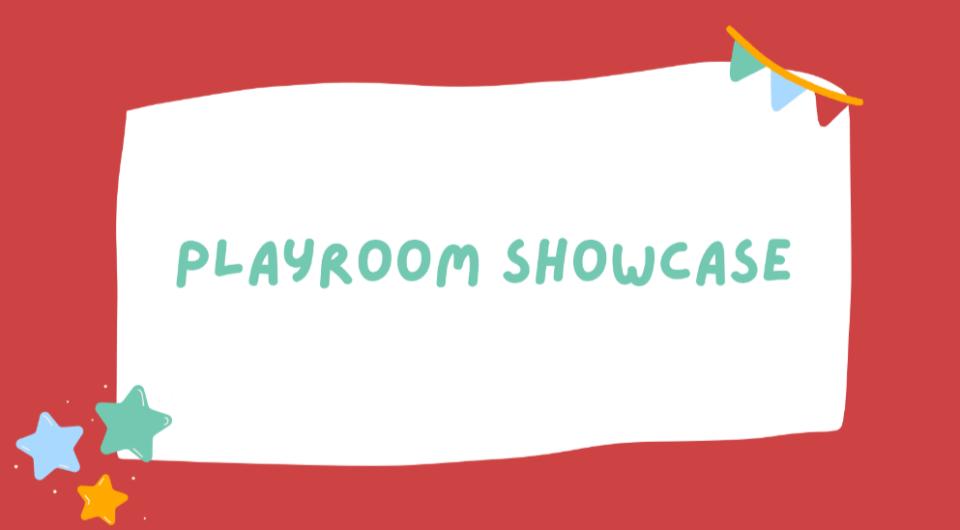
This is an example of what an ideal child-centered play therapy play room will look like. Obviously, different clinics will have different budgets and different utilization of space, different room sizes. But ideally, this is what one would look like in the perfect world.
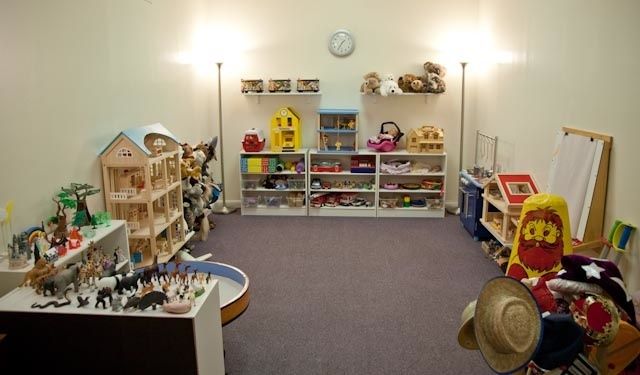
Source: https://www.pinterest.com/pin/3940718412330182/
You can see that there are toys lined up in different categories and organized in very specific ways and they’re all aligned neatly on the side of the room. This is done very specifically, so that way any kiddo who comes in here regularly knows that things are always going to be in the same place at the same time.
This creates a feeling of safety and security for kids, especially kids who have been through trauma as they go in the playroom because even if the outside world is hectic, even if they can’t expect anything to be normal or the same in their regular life, at the very least they know the playroom will be a place where they do have that shortness and that security.
Real-life toys
Really quickly, I wanted to go over some of the main categories for different types of toys. So the first category is real-life toys. And those toys are pretty self-explanatory, toys that imitate objects that a child would see in the real world. So, for example, a toy phone or a toy car. And these are used for children to act out things that they see in their regular day-to-day life through their play.
Aggressive toys
The next category is aggressive toys, things like dark guns, rubber knives, handcuffs, rope, aggressive animals, et cetera. These toys are primarily used for kids to act out their aggressive feelings in a safe way. And I understand that there is some controversy with regards to having a dark gun or a rubber knife in a playroom, but those toys are there for very specific reasons. As I said, they’re used for kids to be able to express themselves and express their anger.
Maybe some of them have negative feelings that they can’t otherwise really express in a healthy way in other environments. But also they could provide an opportunity for kids to learn boundaries. One of the universal boundaries that play therapists will set is people are not for shooting. “I know you’re angry, but people are not for shooting. You can choose to shoot the punching bag or you can choose to shoot one of the stuffed animals”.
This way they’re still able to get those aggressive feelings out, but they learn to use them on inanimate objects. And also, some kids just love target practice. There are no aggressive feelings when using a dark gun. They just like shooting stuff down.
Expressive creative type toys
The third category that I’m going to talk about today is the expressive creative type toys. So things like Play-Doh, Silly Putty, building blocks, arts and crafts, construction paper, scissors, crayons, paint, et cetera.
These toys are meant for children to be able to express their imaginations in basically a vibrant amount of ways, but also to further develop a sense of mastery as they do things like build a certain structure however they want to and learn how to do that.
Filial Therapy
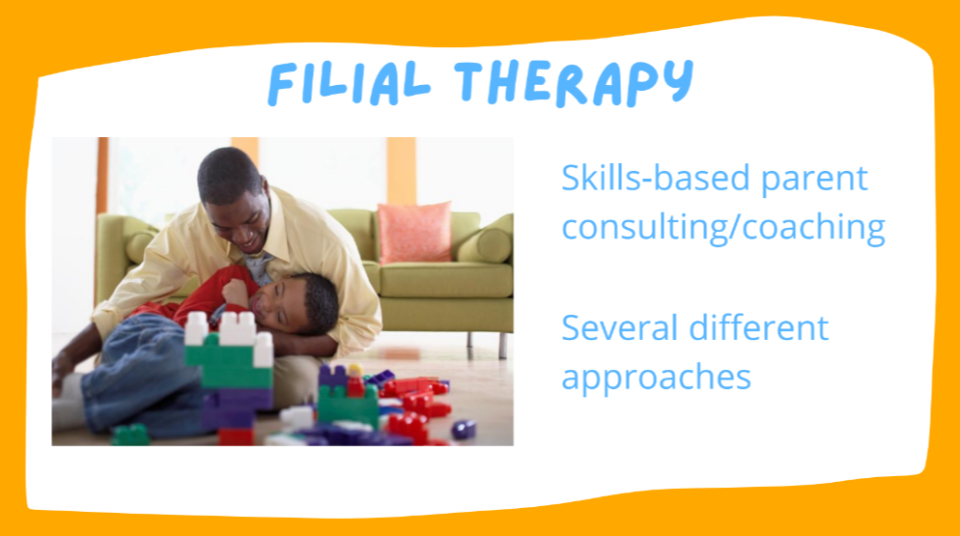
Now moving on from play therapy, we’re going to be going into filial therapy with a brief introduction. Filial therapy is different than play therapy in that instead of guardians bringing their child to a counseling clinic to meet with a therapist one on one, one of the child’s guardians becomes the therapeutic agent.
In filial therapy, parents learn play therapy skills from one or more play therapists and have their own special play times with a child of focus. The rationale behind this model is that parents and guardians already have a well-established relationship with their children, so using them as agents of change could promote swifter, longer-lasting benefits.
Just like with play therapy, there are several types of filial therapy that each emphasize different components. Each of them is also generally based on a model of play therapy.
Child-Parent Relationship Training (CPRT)
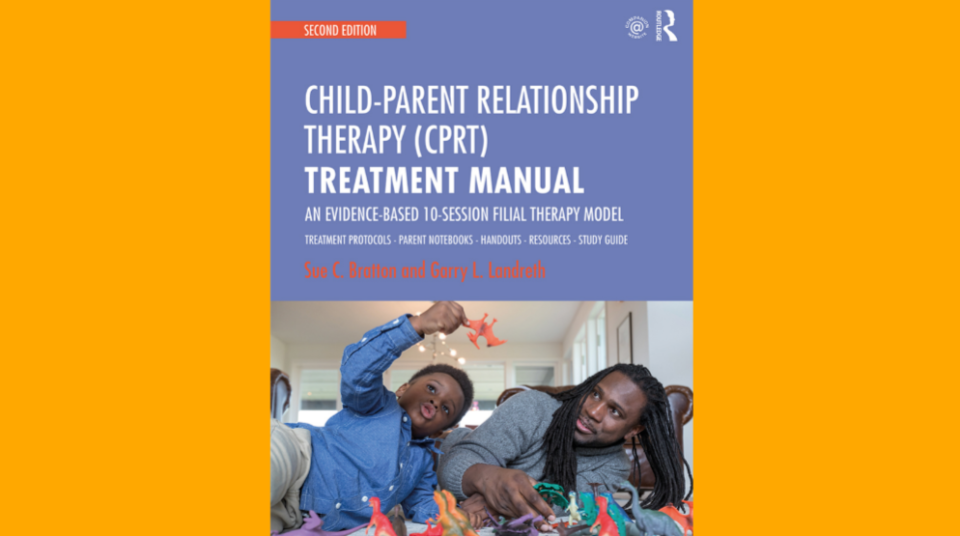
I’ll be speaking about the specific type of filial therapy that I practice, which is called Child-Parent Relationship Training. This model is based on CCPT, which would also make it a part of the person-centered tradition.
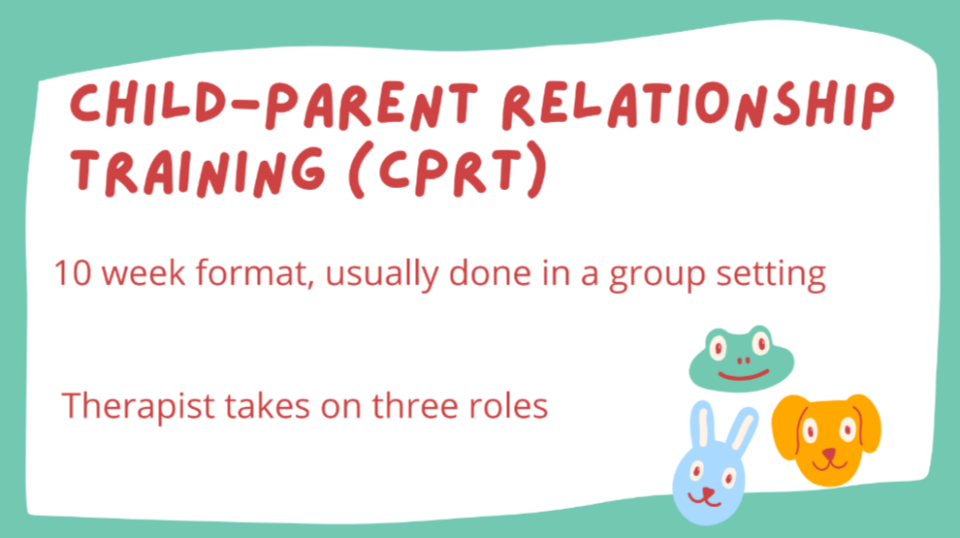
Child Parent Relationship Training, also known as CPRT, is a ten-week long psycho-educational training usually done in a group. However, it can be done individually. The group format allows for parents to support each other as they go through this training and instills a sense of normalcy as they discuss the difficulties of being a parent amongst the other benefits of being in a group.
If it’s done in a group setting, it is encouraged that there be two co-facilitators so as to best meet the needs of multiple people at once.
During CPRT sessions, the therapists/cofacilitators simultaneously take on three different roles a therapist, a teacher, and a supervisor.
The quote-on-quote therapist role is expressed by reflecting on parents’ feelings, validating their experiences, and using other essential skills that one might use in a typical counseling session. As a teacher, the therapist teaches play therapy skills that they have been personally trained in so that the parents can incorporate them in their own special play times.
The goal is for parents to be able to then generalize these skills to their day-to-day lives by the end of the ten weeks. Finally, the supervisor role is fulfilled at the beginning of each session starting at about the fourth week. All parents are instructed to practice their special play times once per week and to record them to then demonstrate to the group. The therapist or co-facilitator then provides feedback on what the parent did well and how they can improve for next time. Group members are also encouraged to politely participate in the section as well emphasis on politely.
It should be noted that while the co-facilitators will demonstrate the essential counseling skills while teaching a CPRT group, they are not the parents” counselors. At the end of the day, the focus is on the content and the cofacilitators must carefully balance time spent between supervising, teaching, and helping.

By now you may be able to guess what the focus of CPRT is. But first I want to pose a question to the group.
When you think of a donut, what is the very first thing that comes to mind?
Just type the very first thing typing in the chat. Here are your responses: sweet, yum, tasty, pretty, creative looking, not so healthy. I also bet that when people think of a donut, the first thing they think of is a hole. Now, this is a very common answer when parents are asked this question in the first CPRT session.
Despite how sweet and lovely donuts are, it is easy for our minds to instantly focus on the problem that there was a hole and we were robbed of more potential donuts. What a tragedy.
In the same way, when parents think of their children, sometimes the first things that come to mind are all the problems that they wish weren’t there. Some parents may even view their children as problems in and of themselves. These can be very loving, well-intentioned parents. But all the same, the focus is first placed on the problem. By focusing on the whole, we miss out on how wonderful the donut is.
By focusing on the child’s problems, we miss out on how wonderful the child is.
The focus of CPRT is on the parents relationship with their child of focus. The child is not the problem. The problem is the problem.
The cofacilitator’s role is to help the parents bolster their bond with their childhood focus, which in doing so can often lead to behavioral issues being sorted out in other ways. As I mentioned before, CPRC has a wide breadth of research supporting its efficacy, one of them being creating closer connections with families of adopted children.
Helping parents to develop a closer bond with adopted kiddos has found to reduce overall behavioral issues with the children, reduce stress for both parents and children, and increase the parents senses of empathy for their children. In addition, the environment created by parents and their special play times has been shown to create a sense of safety, security, and acceptance for traumatized children. And one of the recurring themes that you’ll find in any article about CPRT is that it helps create a deeper sense of parental acceptance for their children and a decrease in stress within the overall parent-child relationship.
Efficacy of CPRT
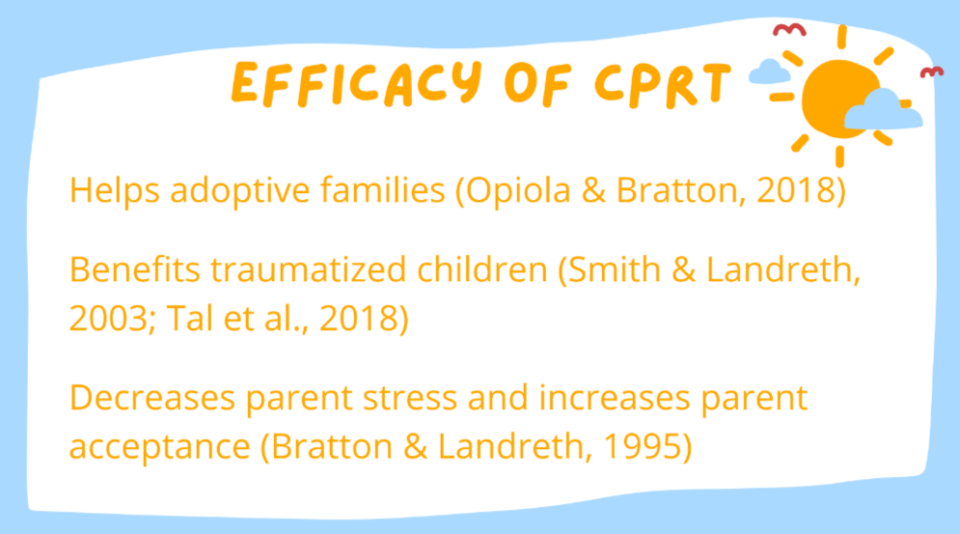
As I mentioned with the child-centered play therapy slide about how its efficacy and whatnot, this is by no means an exhaustive list. These are just a few of the documented highlights of how CPRT has been helping families over the decades.
Cultural Factors

Another key highlight of both CCPT and CPRT is that they are both sensitive to the needs of children and families from a multitude of cultural backgrounds using the chat feature.
Why do you think that is? Why do you think this is culturally responsive?
Seeing here are some of the responses: open-ended, they react to play regardless of where they’re from, children will naturally play, and the approach is client focused so it’s not based on the therapist on culture.
I saw a lot of great things there, and they all actually tie into the exact reason why this is.
The biggest factor for why this approach is useful across multicultural backgrounds is because the play therapist does not allow their cultural perceptions and biases to influence therapy.
By focusing exclusively on the relationship through the viewpoints of the be with attitudes, the play therapist allows for an environment in which the child can express their cultural heritage. They do not bring in their own agenda or expectations for how the session will unfold, and they do not attach labels to any of the toys until the child has done so first.
So, for example, if a child picks up something that obviously looks like a Teddy bear, the therapist withholds saying that it’s a Teddy bear until the child has given it some kind of name or said that it is something. This is because such actions would contaminate the playroom with the therapist’s needs and perceptions and thus derail the child from being in the lead, which is the whole point.
The child-centered approaches to both Filial and play therapy focus on the child’s perceptions, needs, ideas, and identities.
In doing so, the child is free to express their most authentic self and incorporate their cultural background in their play, as opposed to the play therapist warming in their own culture.
Now, of course, I want to perhaps address the elephant in the room that you can’t simply never bring your culture with you. It’s not like you can just turn off a light switch in your head where you’re just acultural. So obviously, no matter what kind of situation you’re in, you’re going to be bringing elements of your culture. Play therapy is no different, but at least in this regard, the play therapist does everything in their power to limit their own cultural biases, or at the very least, be aware of them whenever they’re interacting with the child.
The same thing goes for parents facilitating special play times in CPRT although cultural considerations for parent-child interactions are always on the table. For example, in many collectivist cultures, the notion of allowing children to do everything on their own may be uncomfortable. Therefore, in instances where the child asks for help doing something, the parent may suggest that they work on the task with the child. Doing so still allows the child to have some agency and a sense of accomplishment upon finishing the task while maintaining the family’s cultural norms.
References
Here are my references so that you all know I wasn’t making stuff up.

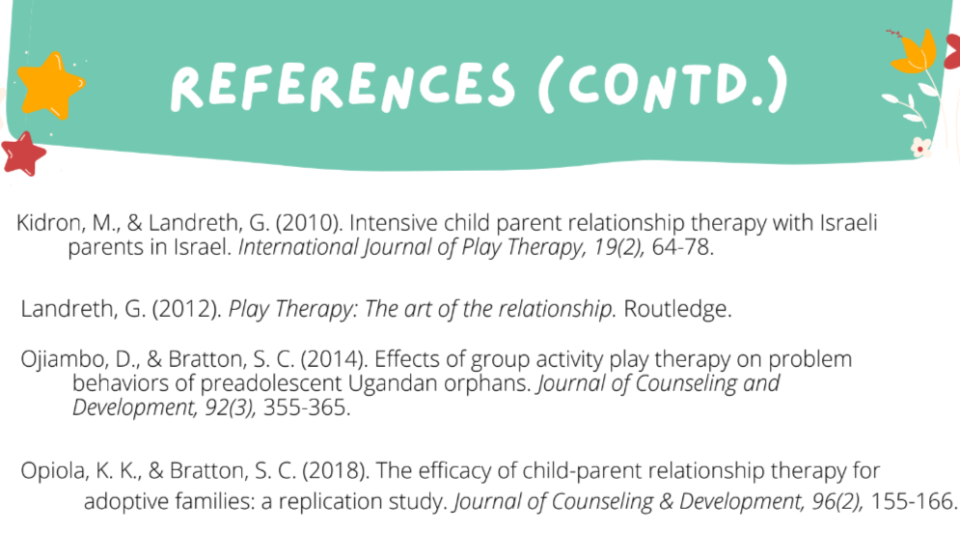
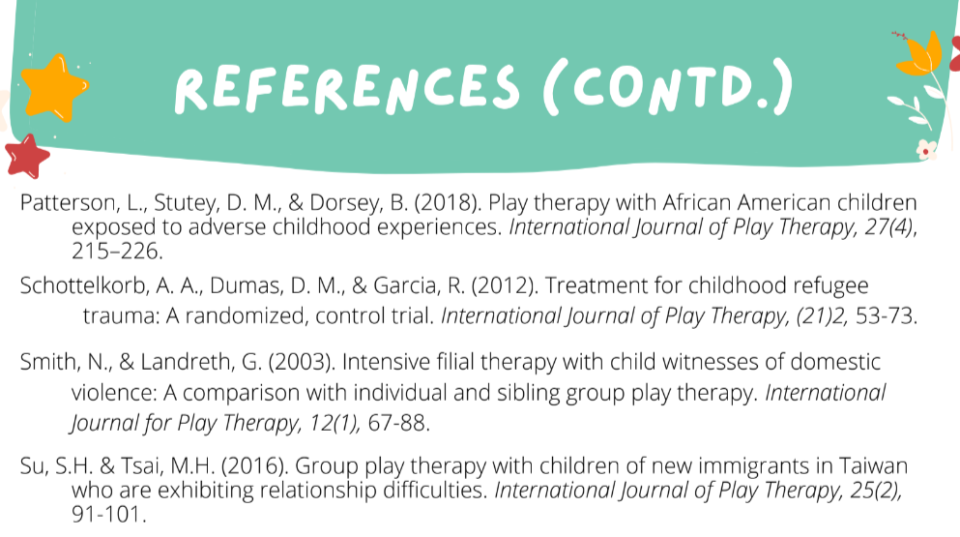
Questions
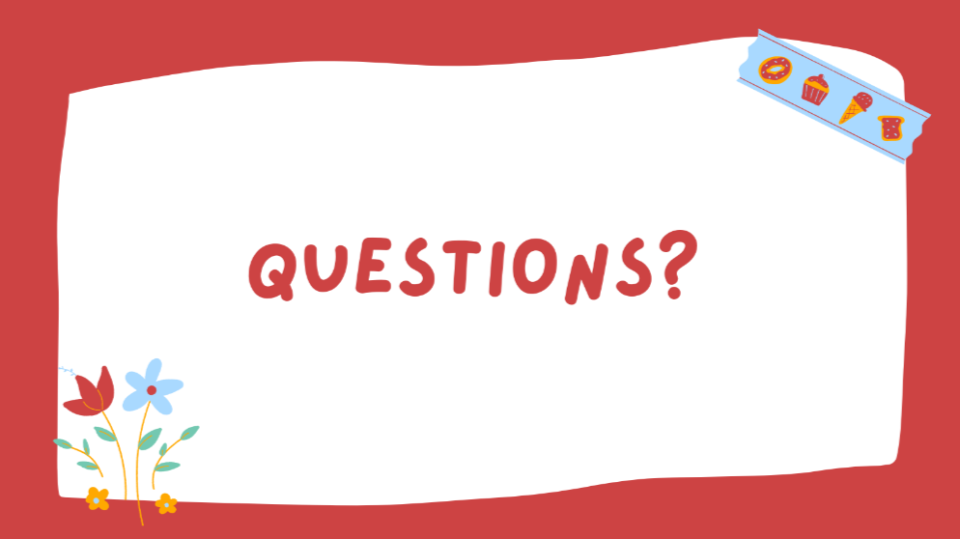
What questions do you all have for me?
Thoughts on using Play Therapy with adults
I would circle back to the development aspect that we talked about earlier, where of course, there are some adults who may be more cognitively delayed than other adults and they might be more cognitively in line with perhaps children. And in those instances developmentally, it would be appropriate to use play therapy with adults.
Now, I myself have not personally done so yet, but I’m open to the idea, of course, with a consultation. That is certainly an area that I think could use more research and could be a very interesting avenue to pursue. But in my professional opinion, I think play therapy for certain adults could be effective, depending on their cognitive development.
Also when I explain play therapy to some adults, they get excited and say: “Well, why can’t my therapist do that? I want to play with swords and stuff”.
When is Child-Centered Play Therapy most effective?
I will address two things. First, “when” perhaps in terms of age. Like I said, that general three to eight age range, although I’ve had several nine-year-olds as play therapy clients as well.
But in terms of presenting concern, what we’ve noticed through the research and through my own clinical experiences and the clinical experiences of my colleagues is that it can be appropriate, for a wide variety of issues because the therapist comes in with a blank slate. They aren’t coming in with any kind of agenda or trying to pigeonhole the client to do something.
It could be for that three to eight to nine age range, and it can be useful for a variety of different things.
Is there a child age that is too young to participate in Play Therapy?
The answer is yes. Of course, infants are certainly too young. Toddlers are interesting for a variety of reasons, one of them being that they are going through very rapid development, not only rapid physical development but also rapid mental and emotional development.
I could potentially foresee maybe a two-year-old or upper two potentially being a candidate for play therapy in much the same way that maybe a three-year-old who is maybe cognitively delayed or something like that presents more as a two-year-old or a younger toddler might not be an appropriate candidate for play therapy.
The short answer is yes, and that’s because we want to be responsive to the child’s developmental needs and a lot of the research has been for that three to eight age range. But there have been, how should I say there have been modifications for CPRT for toddlers, for parents having special play times with children younger than three. So there have been accommodations for that age range.
What are the most necessary items to have in a play therapy room when just starting up?
I don’t have the list off the top of my head, but going back to the three main categories, you want to have a good number of toys, not a whole lot, but a fair amount of toys that represent those three categories.
So, something like a play phone, play car, maybe a dress-up thing like a cape or a tiara. For the aggressive toys, you would need a dark gun, and a rubber knife would be helpful. Handcuffs are also relatively cheap, some kind of musical instruments for the expressive part. Now there are also plenty of playrooms that have musical instruments. So something cheap like a little toy drum or harmonica.
For arts and crafts things, construction paper, safety scissors, glue, colored pencils, things like that. So just having a couple of things that represent each category. There are certainly place therapists who do house calls, much in the same way that doctors used to do house calls back in the day. Place therapists have also sometimes done that.
I personally did that when I was still in grad school for clients. And we would have a tote bag playroom. In that tote bag, you can have the minimum number of toys, like a baby doll, a couple of animals, the toys that I mentioned earlier etc. So I would say those are the most necessary.
Cost-effectiveness of toys
Going back to what I mentioned earlier with cost effectiveness, one thing that I always tell parents in CPRT, as we’re talking about what kinds of toys to have and the rationale for those toys is that you do not need the fanciest and newest things. You can absolutely use hand-me-downs, or borrow toys from other people. Now in CPRT, you’re going to give it back and for play therapy, it’d be more of a donation.
You can use hand-me-downs, as well as yard sales. A lot of really great toys are selected at yard sales, or you can even make your own toys, perhaps. I know that instead of a doll house, you could have a piece of cardboard and you draw different rooms in the house, and the furniture is placed on top of those rooms.
That brings up another really good point.
In Play therapy, toys are selected, not collected.
What I mean by that is that the play therapist doesn’t just grab a bunch of random Happy Meal toys, throws them haphazardly into a playroom, and says: “All right, kid, go for it”.
The toys that are chosen for the playroom are selected very specifically because they are toys that can allow kids to express themselves in a variety of different ways. And one of the things that we try to avoid, is it’s not always possible that we try to avoid our action figures of recognizable figures like Captain America, for example. A kid sees Captain America and he can only be good. He’s only a good guy.
And so if you just have a regular wooden action figure that a kid wouldn’t recognize, that could be a good guy, it could be a bad guy. The kid gets to make up that own story. So that was a long-winded answer, but hopefully, that was sufficient.
Do you ever use video games?
I’m going to preface this by saying that I love video games. I played video games ever since I was two, honestly. And parents don’t worry, I still graduated from grad school. I played them all throughout my childhood and adolescence, and I still continue to do so. I love video games.
However, I would never use one in the context of play therapy. The reason for that is within a video game, there are only so many things that you can really do. So if you’re playing a story-based video game, you have to finish the mission, you have to finish the quest. Even if you’re playing a more open-world video game, there are really only so many things that you can do.
Whereas in a playroom, if a kid is playing with a baby doll and an action figure, they can decide: “Oh well, this character flies and they can fly because I’ve decided they can fly”. Well, in a video game. If your character can’t fly, there’s nothing you can do about it.
Do you ever use board games and books?
And so ultimately, it’s the same reason that we don’t incorporate board games or books in child-centered play therapy. Of course, board games are a lot of fun and books are important. It’s really good for kids to read. With a book, kids come in with the expectation of there’s only one thing they can do with the book. I read it from start to finish, I read it from left to right, I turn the pages, etc. And board games, especially the more recognizable ones, have rules and whatnot. And also it can just be a pain to set up everything for the kid and that takes up a lot of time.
So again, another long answer, but the short answer to that: No, only because neither video games, board games nor books are helpful in the context of allowing a kid to express themselves in most of the ways they want.
If a child refuses to play, what would you do?
So, if a child refuses to play, they can choose not to play. My role in that would just be to continue to track their movements and reflect their feelings based on what they’re doing. So if a kid comes and sits down and they choose not to play with anything, there’s still a lot of information you can pick up from that:
- What’s their facial expression?
- Are they oriented towards you or away from you? In other words, are they facing you?
- Do they have their back turned to you?
- Are they making any noises?
I’ve had some kids give very deep size and I can say, you’re really tired right now, but I’ve had kids just sit there and scream at me and I reflect, you’re really angry right now, and that’s okay for them to be angry. The child can choose to play and they can also choose not to play.
Again, it goes back to the notion that the child is in the lead. They are going to bring in whatever it is that they need to bring in and they’re going to work on their stuff on their own time. And it can be difficult for beginning play therapists because they’re just sitting there thinking, “Well, now, what do I do to shoot?”
When you really take the time to just notice and pay attention to a child’s nonverbals, you can still pick up a world of information even if they aren’t playing.
What is the common length of a play therapy session?
The common length is 45 minutes. And if in instances where the child perhaps takes longer to leave and that’s happened plenty of times, the kids just having so much fun they don’t want to leave the playroom and it could take several minutes for them to leave. If that becomes a habit of consistency, then the play therapist might intentionally end the session a few minutes early to anticipate the child taking a little while to leave.
And it’s 45 minutes because in the 15 minutes span of time until the end of that hour, the therapist has to clean up the room and perhaps do any notes. And the therapist cleans up the room because toys are the child’s words, and play is their language. If you force the kids to clean up the room after a play therapy session, that’s the equivalent of making them take back their words or they may not express themselves in the same way going forward because they’ll be afraid to make a mess. So 45 minutes, but the entire hour is used by that play therapist.
Thank you so much for joining in. I want to be mindful of your time. If I wasn’t able to get to your question today, feel free to just send me an email. My name is Joey, I work at Eddins Counseling Group, a private practice mental health clinic with locations in the Heights and Montrose. We put out a ton of great articles about a variety of mental health topics so feel free to follow us on social media to check all those out. Thank you all again for participating today. You have been a great audience and I’ll see you all another time. Y’all take care.

